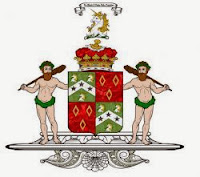THE DUKES OF ROXBURGHE WERE THE SECOND LARGEST LANDOWNERS IN ROXBURGHSHIRE, WITH 50,459 ACRES
This family and the Kerrs, Marquesses of Lothian, descended from two brothers, RALPH and JOHN, originally of Normandy, who passed from England into Scotland sometime in the 13th century, and laid the foundation of those two illustrious houses - Ralph, that of the Kerrs, Marquesses of Lothian; and John, that of the Kers of Cessford; of which the latter family, the eleventh in descent from the founder, SIR ROBERT KER (1570-1650), Knight, of Cessford (elder son of William Ker, of Cessford, warden of the Middle Marches, by Janet, daughter of Sir William Douglas, of Drumlanrig), was elevated to the peerage, in 1600, as Lord Roxburghe; and created, in 1616, Lord Ker of Cessford and Cavertoun, and Earl of Roxburghe.
This nobleman accompanied JAMES VI, King of Scotland, into England, and was Lord Privy Seal in the reign of CHARLES I. His lordship wedded Mary, daughter of Sir William Maitland. Upon the decease of his younger and only surviving son, Lord Roxburghe obtained, in 1646, a new charter, entailing his honours and estates upon his grandson, the Hon Sir William Drummond; and after him, upon the three sons successively of his granddaughter Jane, Countess of John, 3rd Earl of Wigtown.
The 1st Earl's aforesaid grandson,
THE HON SIR WILLIAM DRUMMOND (1622-75), succeeding as 2nd Earl of Roxburghe, assumed the surname of KER, and fulfilling the stipulation in the will by marrying his cousin, the Lady Jean Ker, was succeeded by his eldest son,
ROBERT, 3rd Earl (c1658-82) who was one of the privy council of CHARLES II, accompanying The Duke of York from London to Scotland in HMS Gloucester.
His lordship was lost on the coast of Yarmouth, in 1682, leaving issue by his wife, Mary, daughter of John, 1st Marquess of Tweeddale (who survived him and remained a widow 71 years), three sons, of whom the eldest,
ROBERT (c1677-96) succeeded as 4th Earl; at whose decease, unmarried, the honours devolved upon his brother,
JOHN, 5th Earl (c1680-1741); who, having filled the office of Secretary of State in 1704, was installed a Knight of the Garter, and created, in 1707, Viscount Broxmouth, Earl of Kelso, Marquess of Cessford and Bowmont, and DUKE OF ROXBURGHE, with remainder to the heirs who should inherit the earldom of Roxburghe.
His Grace espoused Mary, daughter of Daniel, Earl of Nottingham, and widow of William, Marquess of Halifax; and dying in 1741, was succeeded by his only son,
ROBERT, 2nd Duke, who wedded, in 1739, Essex, eldest daughter of Sir Roger Mostyn Bt; and dying in 1755, was succeeded by his son,
JOHN, 3rd Duke; the celebrated book collector, who was installed a Knight of the Garter and a Knight of the Thistle; but dying unmarried, in 1804, the British honours expired, while the Scottish devolved upon His Grace's kinsman,
WILLIAM, 7th Lord Bellenden, as 4th Duke.
FLOORS CASTLE, near Kelso, Roxburghshire, was built in the 1720s by the architect William Adam for the 1st Duke of Roxburghe, possibly incorporating an earlier tower house
In the 19th century it was embellished with turrets and battlements by William Playfair for the 6th Duke.
Floors has the common 18th-century layout of a main block with two symmetrical service wings.
The 5th Earl of Roxburghe commissioned the Scottish architect William Adam (1689–1748), father of Robert Adam, to design a new mansion incorporating the earlier tower house.
It was built between 1721-26, and comprised a plain block, with towers at each corner.
Pavilions on either side housed stables and kitchens.
Ca 1837, the 6th Duke commissioned the fashionable architect William Playfair to remodel and rebuild the plain Georgian mansion house he had inherited.
The present form of the building is the result of Playfair's work.
In 1903, the 8th Duke married the American heiress May Goelet, who brought with her from her Long Island home a set of Gobelins Manufactory tapestries, that were incorporated into the ballroom in the 1930s, and added to the collection several modern pictures by Walter Sickert and Henri Matisse, among others.The 10th and present Duke and Duchess undertake the huge responsibility of maintaining and protecting the treasures to ensure that they can be enjoyed by future generations.
In 2010, the installation of a biomass boiler providing a source of renewable heat energy marked the next page in the history of Floors Castle.
First published in January, 2014. Roxburghe arms courtesy of European Heraldry.





2 comments :
I'm sure the tenth duke died last year.
Thanks for letting me know, Andrew.
Post a Comment